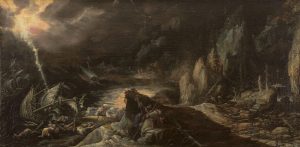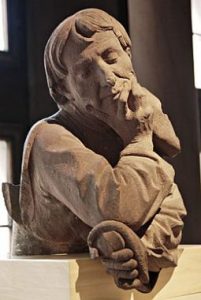Dutch and Flemish Renaissance painting represents the 16th-century response to Italian Renaissance art in the Low Countries. These artists drew on both the recent innovations of Italian painting and the local traditions of the Early Netherlandish artists.

Image source: https://en.wikipedia.org/wiki/The_Wedding_Dance#/media/File:Pieter_Bruegel_de_Oude_-_De_bruiloft_dans_(Detroit).jpg
Dutch and Flemish painters were also instrumental in establishing new subjects such as landscape painting and genre painting. Joachim Patinir, for example, played an important role in developing landscape painting, inventing the compositional type of the world landscape, which was perfected by Pieter Bruegel the Elder who, followed by Pieter Aertsen, also helped popularise genre painting.
The style evolution
The influences of the Italian Renaissance begin to manifest themselves in Dutch painting around 1500, but the older style was remarkably persistent. Antwerp Mannerism is a term for painters who display some Italian influence but continuing to adopt the style and subjects of the older masters. Hieronymus Bosch is an individual artist, whose work is strange and full of seemingly irrational imagery, which makes it difficult to interpret. It looks modern, introducing a world of dreams that seems more related to Gothic art than the Italian Renaissance, despite some Venetian prints from the same period showing a comparable degree of fantasy. The Romanists were the next stage of influence, adopting the Italian styles in a much more comprehensive way.

Image source: https://commons.wikimedia.org/wiki/File:Follower_of_Jheronimus_Bosch_Christ_in_Limbo.jpg
After 1550
After 1550 the Flemish and Dutch painters begin to show more interest in nature and beauty “in itself”, leading to a style that incorporates Renaissance elements but remains far from the elegant lightness of Italian Renaissance art, and directly leads to the themes of the great Flemish and Dutch Baroque painters: landscapes, still lifes and genre painting – scenes from everyday life.

This evolution is seen in the works of Joachim Patinir and Pieter Aertsen, but the true genius among these painters was Pieter Brueghel the Elder, well known for his depictions of nature and everyday life, showing a preference for the natural condition of man, choosing to depict the peasant instead of the prince.
The fall of Icarus

Image source:https://en.wikipedia.org/wiki/
The Fall of Icarus (now considered a copy of a work by Bruegel), combines several elements of Northern Renaissance painting, albeit in many ways highly atypical. It alludes to the renewed interest in antiquity, but the hero Icarus is hidden in the background. The main actors of the painting are nature itself and, the farmer, who doesn’t even look up from the plow when Icarus falls. Brueghel shows man as an anti-hero, comical, and sometimes grotesque.
Architecture and sculpture
As in painting, Renaissance architecture took some time to reach the High Countries and did not entirely supplant the Gothic elements. The most important sculptor in the Southern Netherlands was Giambologna, who spent most of his career in Italy. An architect directly influenced by the Italian masters was Cornelis Floris de Vriendt, who designed the city hall of Antwerp, finished in 1564.

Image source: https://fr.wikipedia.org/wiki/Nicolas_Gerhaert_de_Leyde
In sculpture, however, 15th-century Flemish artists, while adhering to Christian subjects, developed techniques and a naturalistic style that compares favorably to the work of early-Renaissance Italian contemporaries such as Donatello. Claus Sluter (fl. ~1400) produced works such as the Well of Moses with a dynamism almost unknown at the turn of the 15th century, and Dutch-born Nikolaus Gerhaert van Leyden (b. ~1420) made sculptures such as “Man Meditating” which even today appear more “modern” than does Italian Quattrocento carving.
Info sources: https://www.hisour.com/ https://enacademic.com/dic.nsf/enwiki/3471208 https://en.wikipedia.org/wiki/Renaissance_in_the_Low_Countries https://en.wikipedia.org/wiki/Dutch_and_Flemish_Renaissance_paintin
